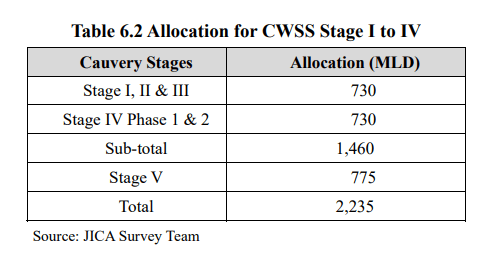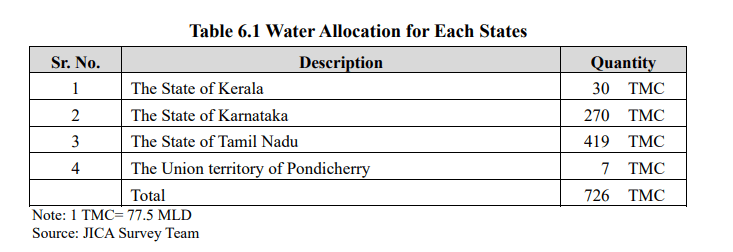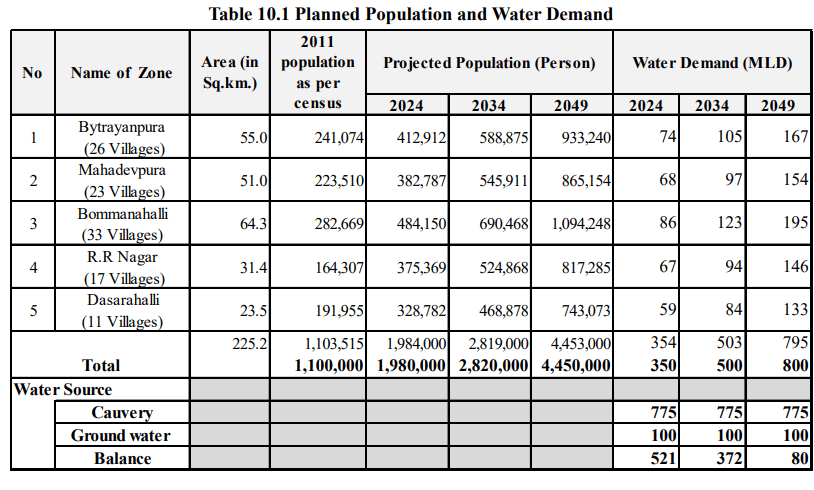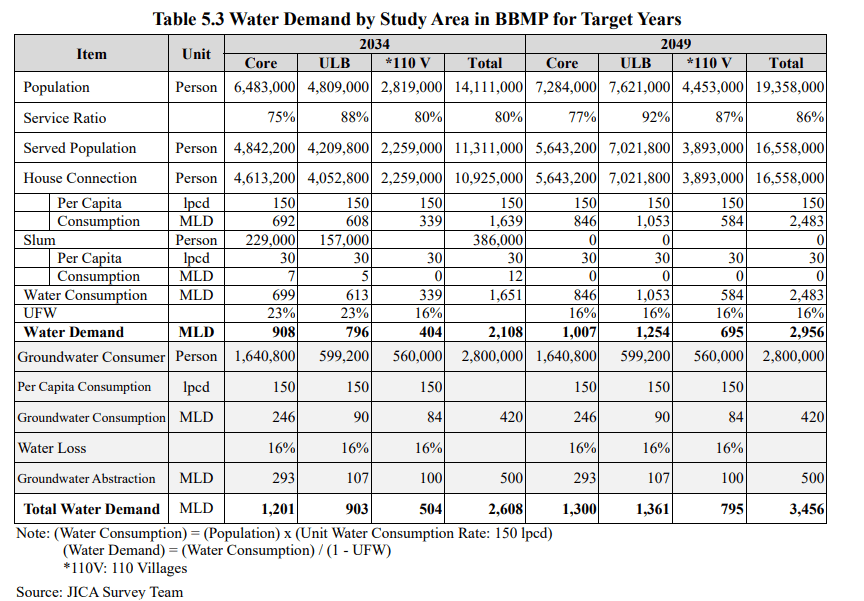Every summer, Bengaluru grapples with its recurring water crisis, despite increased allocation of Cauvery water by the Supreme Court. The city currently has access to 24 thousand million cubic feet (TMC) of Cauvery water, but even with this supply, the Chief Minister admitted last summer that Bengaluru still faces a shortage of 500 million litres per day (MLD).
So, will Bengaluru reach water sufficiency this year? Or will the struggles of 2024 — when some areas of the city faced acute water shortage — be repeated? Speaking to Citizen Matters, Ram Prasath Manohar, Chairman, Bengaluru Water Supply and Sewerage Board (BWSSB) said: “Currently, we have completed 89,000 connections under Cauvery Stage V. With all five stages running at full capacity, the current water supply can sustain us till 2028.” However, he cautioned that overuse driven by the availability of surplus water could lead to a crisis next year.
While Cauvery Stage V hasn’t reached its full potential, the larger issue of Bengaluru’s dependence on groundwater has not been addressed. The city’s groundwater is heavily exploited, leaving Cauvery as the reliable source for potable water. Here, we examine the history of the Cauvery River’s connection with Bengaluru, the current status of Stage V and the uncertain future of water availability in the city.
Water supply to the periphery
The long-awaited Cauvery Stage V, which was inaugurated on October 16, 2024, aims to bring 775 MLD of water to the 110 villages in the city’s periphery, which were included in the Bruhat Bengaluru Mahanagara Palike (BBMP) limits in 2006-07. This project also involves the construction of one of India’s largest Water Treatment Plants (WTP) with a capacity of 775 MLD, through which the current water supply is being filtered and transported.

The estimated cost of the Cauvery Stage V project is ₹4,336 crore and is funded through a loan from the Japan Infrastructure Cooperation Agency (JICA). The project aims to provide Cauvery water to 50 lakh new beneficiaries across Bengaluru through four lakh new connections, with water supply slated to reach every house in Yelahanka, Yeshwanthpura, Bangalore South, Byatarayanapura, T Dasarahalli, Mahadevapura, Rajarajeshwari Nagar and Bommanahalli zones.
Under the Stage V project, the government completed and commissioned a 69.5-km transmission pipeline from TK Halli to Vajarahalli in January 2025. Of the 110.6 km traunk main pipeline in Bengaluru, 110 km have been built and put into service; the remaining 600 metres are pending due to delays in land acquisition and the Bengaluru Electricity Supply Company’s (BESCOM) cable obstructions close to the Kadugodi ground-level reservoir.
Bengaluru’s water needs
- As per BWSSB, water demand in Bengaluru is nearly 150 to 200 litres per capita per day (lpcd), but the average supply was about 100 to 125 lpcd in 2021.
- According to data compiled by WELL Labs, the city’s demand for freshwater is approximately 2,632 MLD, of which 1,460 MLD is supplied from the Cauvery River. Domestic demand alone adds up to 1,890 MLD, exceeding Cauvery extraction, forcing people to depend on water from expensive tankers and drying borewells.
- In 2023, nearly 50% (1,372 MLD) of Bengaluru’s needs were met through groundwater extraction, with the repletion rate (148 MLD) significantly lower than the extraction rate. With overexploitation of groundwater, the availability dropped to only 800 MLD. Today, the city needs an additional 1,680 MLD to meet its water needs.
Read more: Compulsory Cauvery connections won’t solve Bengaluru water crisis: Citizens, experts
What is the Cauvery Water Supply Scheme?
A total supply of about 185 MLD from the Arkavathi scheme was grossly inadequate to meet the demand of about 16 lakh population in the late sixties. Since 1974, as the city expanded and its water needs grew, the Cauvery River was tapped as a source and developed in stages for water supply to Bengaluru. Supply from the Arkavathi River is nil as the river dried up decades ago.

Distribution of Cauvery water
The Gazette notification, dated February 20, 2013, by the Government of India, Ministry of Water Resources ordered the Cauvery River water to be allocated to the three states of Karnataka, Kerala and Tamil Nadu as well as Union territory of Pondicherry for their uses, as follows:

In 2018, the Supreme Court increased the allotment of Cauvery water for Karnataka by 14.75 TMC, including 4.75 TMC specifically for Bengaluru’s drinking and domestic needs. With this increase, Karnataka’s total share of Cauvery water became 284.75 TMC, and Bengaluru’s share increased to 24 TMC.
How Cauvery reaches your doorstep
From the Krishna Raja Sagar (KRS) reservoir 90 kilometres away and 350 metres lower than the city’s elevation, 1,460 MLD of Cauvery River water is extracted. Through four stages of the Cauvery Water Supply Scheme (CWSS), water has been conveyed from the river to TK Halli (Thorekadanahalli) Water Treatment Plant (WTP) and pumped up through Harohalli and Tataguni pump stations, before it reaches the city at a point named Vajarahalli, near Banashankari 6th stage. The water is distributed to the BBMP areas from here to 56 Ground Level Reservoirs (GLRs) from where it is distributed across the city and surrounding areas.

Source: JICA
Through the Cauvery Stage V project, water is being transported throughout the suburbs of Bengaluru via a steel trunk main pipeline, arriving at reservoirs in Gottigere, Doddakanahalli, Lingadhiranahalli, SMV 6th Block, Kadugodi, and Chokkanahalli.
How far is water from Stage V reaching?
BWSSB had set its target of an ambitious three lakh connections within one month of the launch, and has only managed 89,000 connections so far, with no clear date of completion yet. Residents pointed out high pro-rata charges, middlemen exploitation, and poor technical support as reasons for not applying, as reported by The Hindu.
In November 2024, water supply to 31 villages in the KR Puram and Mahadevapura constituencies was delayed because of challenges in pipeline work, particularly hard rock below the ground. The water supply to several areas, including Hagadur, Channasandra, Panathur, Gunjur and surrounding villages in Mahadevapura also had to wait till at least January 2025 due to the slow pace of work.
However, Ram Prasath insisted, “Right now, everyone who has a connection is getting water. If anyone with connections is not receiving water, let me know, I will resolve the issue.”

In January 2025, water supply to eight villages — K Narayanapura, Geddalahalli, Byrathi, Bilishivale, Chokkanahalli, Thirumenahalli, Bellahalli, and Kattigenahalli — was pending due to land acquisition issues in Kadugodi and Chokkanahalli, which are delaying reservoir construction. “Of 110 villages under Stage V, 104 villages have received water already. We are not able to provide water for six villages owing to land issues, which will be resolved soon,” added Ram Prasath.
How successful were the earlier stages?
Since the 1970s, the CWSS scheme has provided potable water to millions of households. While Bengaluru extracts 1,460 MLD of Cauvery water currently, a lot of it fails to reach households due to two key issues: residents avoiding Cauvery connections due to high costs and lack of trust in BWSSB, and significant water loss or theft.
For example, residents of Ramamurthy Nagar, Horamavu, and surrounding areas struggle with water shortages even five years after getting Cauvery connections. A recent Indian Institute of Science (IISc) report identified 80 critical wards at severe risk of water scarcity this summer, many relying heavily on groundwater. This list not only includes wards from the peripheral villages, but wards within the city, which were supposedly covered by the earlier Cauvery water supply stages.
IndiaSpend reports that 50% of the Cauvery water reserved for domestic use in Karnataka is used by Bengaluru alone, with 49% lost in distribution. Ram Prasath told Citizen Matters that this has now reduced to 27%. “We are changing old pipelines and meters to reduce leakages across the city,” he added.
In many areas, water quality is also a concern. In November 2024, 300 BTM Layout residents faced severe health concerns owing to sewage inflow into Cauvery water lines. A similar incident in June 2024, put Whitefield residents at risk. “Last year, we started getting a foul smell in our taps when we received Cauvery water. After confirming the issue with neighbours, we became extremely worried and complained to BWSSB,” said Sandra J, a Whitefield resident. The problem was eventually resolved, and the quality improved, she added.
Despite efforts to augment the water supply, the project has many loopholes and implementation gaps.
Plans for Cauvery Stage VI
While challenges in water supply continue, plans are afoot for the next stage of the CWSS. After three months of Stage V beginning, BWSSB completed the Detailed Project Report (DPR) for Cauvery Stage VI, which is set to supply 500 MLD more by 2028 at ₹6,939 crore. The BWSSB plans to use the service lane of the Bengaluru-Mysuru expressway to directly draw Cauvery water upstream of the KRS reservoir for the sixth phase. The decision was made because of the summertime decline in water flow from the Shiva Balancing Reservoir in Malavalli Taluk and the inability to construct a seventh pipeline on either side of Kanakapura Road because of a lack of space. All the earlier pipelines were laid along this route.
Will Bengaluru be water-sufficient till 2034?
BWSSB’s Ram Prasath insists that the city will not face a water crisis this year. “We’re already in the middle of summer, the situation is stable. We have taken a lot of precautionary measures, chalked out an extensive action plan, and are implementing it,” he promised.

So, what are some of these measures? BWSSB is set to have 10 Cauvery Connect Centres, where residents may purchase 6,000 litres of Cauvery water for Rs 90. However, as reported by TOI, residents see no point in this facility, as they will have to rely on tankers to transport water to their homes.
BWSSB is also preparing to launch “Cauvery on Wheels,” a programme to book Cauvery water from a mobile-based application, which will directly be delivered from 100 Cauvery Water Connect points in the city, removing the middlemen from the process. BWSSB has been arranging 200 tankers for this initiative to benefit those areas where piped water is unavailable.
Meanwhile, tanker water prices are touching the roof. The price of a 12,000-litre private tanker, which was ranging from ₹1,000 to ₹1,200, has begun to shoot up to ₹1,500 to ₹1,700 in the outer zones. BWSSB officials seem hopeful and are urging residents to take water connections. However, Bengalureans are not convinced, amidst a lack of clarity over private tanker regulations, BWSSB developing plans, and pending Cauvery water supply in the city.